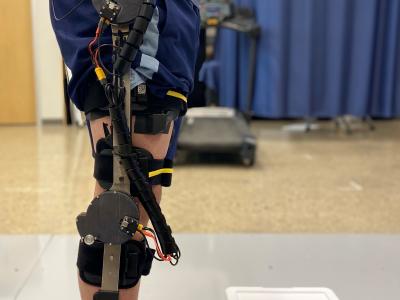Exoskeletons

Developing robust benchmarking methods is crucial for evaluating the standing stability of
bipedal systems, including humanoid robots and exoskeletons. This paper presents a standardized benchmarking
procedure based on the Linear Inverted Pendulum Model and the Capture Point concept to normalize
the maximum angular momentum before falling. Normalizing these variables establishes absolute and relative
benchmarks achieving comprehensive comparisons across different bipedal systems. Simulations were
- Categories:
 79 Views
79 Views
Loss of hand function severely impacts the independence of people with spinal cord injuries (SCI) between C5 and C7. To achieve limited grasps or strengthen grip around small objects, these individuals commonly employ a compensatory technique to passively induce finger flexion by extending their wrist. Passive body-powered devices using wrist-driven actuation have been developed to assist this function, in addition to advancements in active robotic devices aimed at finger articulation for dexterous manipulation.
- Categories:
 38 Views
38 ViewsThis dataset consists of a bill of materials (.PDF) for the equipment and materials used in the fabrication of the M-BLUE hardware, and SolidWorks CAD models (.SLDPRT, .SLDASM) of the custom sheet metal components and 3D-printed spacer used in the M-BLUE assembly. Please download and unzip "MBLUEdataset.zip" to access the files referenced above.
Supplementary material for the article:
C. Nesler, G. Thomas, N. Divekar, E. Rouse, and R. Gregg, "Enhancing Voluntary Motion with Modular, Backdrivable, Powered Hip and Knee Orthoses," IEEE Robotics & Automation Letters, 2022.
- Categories:
 1128 Views
1128 Views
This dataset consists of a bill of materials (.PDF) for the equipment and materials used in the fabrication of the M-BLUE hardware, and SolidWorks CAD models (.SLDPRT, .SLDASM) of the custom sheet metal components and 3D-printed spacer used in the M-BLUE assembly.
- Categories:
 271 Views
271 ViewsReference: Laschowski B, McNally W, McPhee J, and Wong A. (2019). Preliminary Design of an Environment Recognition System for Controlling Robotic Lower-Limb Prostheses and Exoskeletons. IEEE International Conference on Rehabilitation Robotics (ICORR), pp. 868-873. DOI: 10.1109/ICORR.2019.8779540.
- Categories:
 621 Views
621 Views